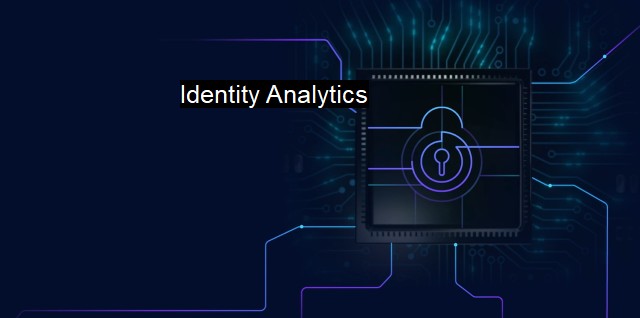What are Identity Analytics?
How Identity Analytics Helps Businesses Keep Cybersecurity Threats at Bay: Insights into the Process of Detecting Anomalous or Malicious Activities
Identity Analytics, primarily, falls under the aegis of enterprise cybersecurity and can be explicated as the relatively branch technology where big data and advanced analytics techniques are harnessed to manage identity and access data. In a world haunted by increasing network vulnerabilities, data breaches, and cybercrimes, businesses scramble to find revolutionary solutions to beef up their security architecture and protect valuable data. Here's where Identity Analytics comes into the picture as an innovative solution transforming the cybersecurity landscape.Generally, people associate cybersecurity efforts with installing antivirus software and other protective barriers. While antivirus software plays a significant role, it is only a part of the broader cybersecurity apparatus needed to shield an organization. There is an increasing cognizance in the market about how an organization's effective defense against cyberattacks not only requires antivirus software but needs more nuanced techniques like Identity Analytics.
First, let's understand how Identity Analytics operates vis-à-vis the cybersecurity domain. Identity Analytics analytically deciphers sensitive identity-based information, like sign-in locations and devices, log-in times, and the consistency of access requests over time. By dynamically evaluating these attributes, Identity Analytics builds user behavior profiles. One fantastic aspect of this technology is these security algorithms continually evolve as more data is consumed, strengthening the security characteristics to a higher level of precision.
The essence of this technology lies in its predictive capabilities. It uses sophisticated machine learning algorithms to foresee potential security threats, making it profound in prevention, detection, and incident response aspects. These predictive capabilities make Identity Analytics an invaluable tool for organizations striving to enhance their cybersecurity apparatus.
Identity Analytics curtails unwelcome access to sensitive data, a primary exploit vector for hackers. It severs avenues that cybercriminals primarily utilize to infiltrate an organization's system. These aspects are paramount in a world where cyber threats are prominent, with entities being threatened with disruptions ranging from financial losses to reputational damage.
Now, the question arises: Why is Identity Analytics critical? In the preceding years, a basic user ID and password pattern laid the foundation of users' online identity verification. With increasing cyber threats like phishing and malware, this model stands obliterated. Thus, Identity Analytics, which forms an essential part of Identity and Access Management (IAM), allows restricting access rights without impinging on user experience.
Regarding Identity and Access Management, organizations are dealing with an increasing number of users trying to access resources via an array of devices and locations. This leads to a profuse galvanization of IAM to detect possible anomalies. Identity Analytics takes on the arduous task of identifying abnormalities in a jiffy, thanks to its Machine Learning technology, which can process a gargantuan volume of data faster and identify potential cybersecurity threats.
To recapitulate, Identity and Access Management, empowered with Identity Analytics, elevates the security structure of an organization by providing granular access controls and developing comprehensive reports on user access and activity. Designing the right identity permissions and security rules in the organization command center needs Identity Analytics primarily. Using cutting-edge analytics makes the process swift, accurate, and reliable.
It's crucial to understand that Identity Analytics initiates an era of cybersecurity that's proactive rather than reactive. While antivirus software and firewalls thwart harmful programs from inflicting damage, Identity Analytics stops potential attacks well before they occur. You can say that an enterprise’s shield is not complete without antivirus software, but it’s effectively uncrackable with Identity Analytics.
By using Identity Analytics, an organization can tackle emerging security threats, enforce security compliance, improve incident response, and protect data privacy effectively. Hence, Identity Analytics does more than just add another layer of security. It revamps the entire security attitude from resistance to resilience, lending a way to vigilante and predictive security – which is the future of the cybersecurity and antivirus domain.

Identity Analytics FAQs
What is identity analytics and how does it relate to cybersecurity and antivirus?
Identity analytics is a cybersecurity tool that uses machine learning algorithms to analyze user behavior data and detect anomalies that may indicate a cyber threat. It is often used in conjunction with antivirus software to provide a more comprehensive security solution.What does identity analytics look for when analyzing user behavior data?
Identity analytics looks for patterns and anomalies in user activity such as login times, locations, devices used, and applications accessed. It can also detect suspicious activity such as attempts to access unauthorized resources or log in with incorrect credentials.Can identity analytics help prevent cyber attacks?
Yes, identity analytics can help prevent cyber attacks by identifying potential threats before they can cause harm. By detecting anomalies in user behavior, identity analytics can alert security teams to unusual activity that may indicate a breach. This early warning can help security teams take action to prevent the attack from succeeding.Is identity analytics difficult to implement and manage?
Implementing and managing identity analytics can be challenging, especially for organizations with limited resources. However, many cybersecurity vendors offer identity analytics solutions that are designed to be easy to use and integrate with existing security tools. Additionally, some vendors offer managed services to help organizations deploy and manage identity analytics more effectively.| | A | | | B | | | C | | | D | | | E | | | F | | | G | | | H | | | I | | | J | | | K | | | L | | | M | |
| | N | | | O | | | P | | | Q | | | R | | | S | | | T | | | U | | | V | | | W | | | X | | | Y | | | Z | |
| | 1 | | | 2 | | | 3 | | | 4 | | | 7 | | | 8 | | |||||||